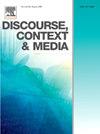Disseminating research results in The Conversation: An analysis of comprehensibility strategies
IF 3.1
2区 文学
Q1 COMMUNICATION
引用次数: 0
Abstract
Recognizing the key role of knowledge dissemination in socio-economic progress, The Conversation is a news website intended to promote the public understanding of science. When using this platform to disseminate their own findings, scholars need to recontextualize their published research to make it suitable for a wide audience. However, despite the potential of this website for improving science literacy, there is little research on the strategies used to render scientific knowledge comprehensible for the general audience. This article studies the recontextualization strategies that researchers utilize to facilitate understanding when reporting their own research in The Conversation. For this purpose, we analyze a dataset consisting of 50 Environment articles. Adopting a multimodal perspective, we propose an analytical framework that can account for the various semiotic resources employed to aid comprehensibility. We analyze the frequency, function and formal features of the following elements that facilitate understanding: (i) verbal in-text elaboration (exemplification, reformulation, definition, analogy and explicitation); (ii) visuals; and (iii) hyperlinks to supplementary information. The results show that the technological features of The Conversation (e.g., hyperlinking, multimodal embedding) shape how researchers adapt and reframe their discourse, enabling a distinctive form of knowledge dissemination. Through this analysis, we aim to shed light on the multimodal recontextualization strategies that facilitate effective knowledge dissemination in science news websites.
《对话》研究成果的传播:可理解性策略分析
认识到知识传播在社会经济进步中的关键作用,“对话”是一个旨在促进公众对科学理解的新闻网站。在利用这个平台传播自己的发现时,学者们需要将他们发表的研究重新置于背景中,使其适合广泛的受众。然而,尽管这个网站在提高科学素养方面具有潜力,但关于如何使科学知识为普通受众所理解的策略的研究却很少。本文研究了研究人员在《对话》中报道自己的研究时使用的重新语境化策略,以促进理解。为此,我们分析一个由50篇Environment文章组成的数据集。采用多模态的观点,我们提出了一个分析框架,可以解释用于帮助理解的各种符号学资源。我们分析了以下有助于理解的要素的频率、功能和形式特征:(i)口头文本阐述(举例、重新表述、定义、类比和说明);(2)视觉效果;(iii)补充信息的超链接。研究结果表明,对话的技术特征(如超链接、多模态嵌入)决定了研究人员如何调整和重新构建他们的话语,从而实现了一种独特的知识传播形式。通过这一分析,我们旨在揭示促进科学新闻网站知识有效传播的多模式再语境化策略。
本文章由计算机程序翻译,如有差异,请以英文原文为准。
求助全文
约1分钟内获得全文
求助全文

 求助内容:
求助内容: 应助结果提醒方式:
应助结果提醒方式:


